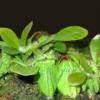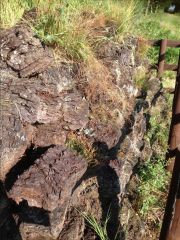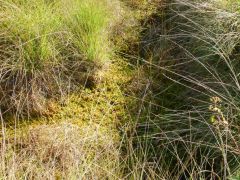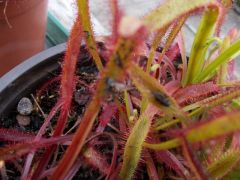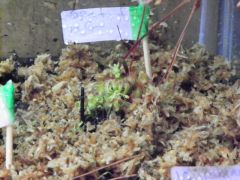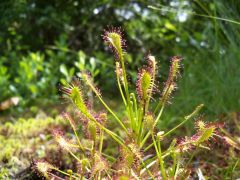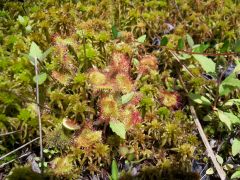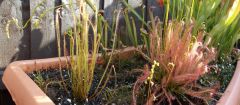Search the Community
Showing results for tags 'drosera'.
-
After some great help from this forum, we ordered three different drosera varieties from Hampshire Plants, which arrived today. I would like a little bit of advice please. The d. binata looks completely dead. Is this normal? I know the pictures on the site are what you can aspire to having, but this is the complete opposite. Also, it's quite dry, and I thought they were supposed to be kept wet. Should I be concerned about the dead-looking state, or is this just the end of the winter rest period? The d. capensis narrow looks mostly dead, but there are a few new leaves starting to grow, so I guess this is just a matter of care and time. This one was fairly moist. Finally, the d. alicae looked quite good. It has plenty of healthy leaves, and no dead material at all. The whole plant is about 4cm across, and is a little bit moist. So, how do I care for them? As far as I can see from their web site, they need to stand in a few centimetres of rain/deionised/RO water.Is that right? I'll worry about winter care nearer the time! Do I need to water them from the top at all, or just put water in the tray underneath? Also, how long would I expect to wait before seeing the capensis and binata grow to the stage where they can catch insects? We have three locations where we would like to put the three plants, and want to know which are suitable... 1) My home office has a south-facing window and is on the first floor. I guess this is ideal, as it gets as much sunshine as we ever get in Manchester! It's not a huge window (about 1m wide), but then it's not a huge plant, and would be right on the windowsill. The room has a couple of computers in it, so doesn't get too cool, but doesn't get too warm as I keep the radiator off. 2) We have ground floor room which has a west-facing window. As the window is about 3m wide, and faces our garden, it gets quite a lot of light, so is pretty good for most plants. It is above a radiator, but due to the idiot plumber who put it in, it doesn't get that hot! 3) We would like to put one in or near the kitchen, partly so we can see it (we spend most of our family time in the kitchen or eat-in next door), and partly to catch any flies that venture near the kitchen. The kitchen doesn't have any windows in the walls, but has a decent-sized skylight. The only place in the kitchen itself would be to put a small shelf inside the skylight, which would give it plenty of light, but would keep it out of sight. The eat-in next to the kitchen has a south-facing window, but there is a sort of outhouse on the other side of the window, which has a plastic roof. This lets a reasonable amount of light in, but not a huge amount. Would I be right in thinking that this wouldn't be a good place for a drosera? We do have a tank with two turtles on that windowsill, and that has a UVB tube and a basking lamp, so there would be a certain amount of extra light, but I don't know if it would be enough. The UVB tube is right over the turtle tank, with a reflector, so doesn't let huge amounts of light out. What do you think of these three locations? Thanks again for all the help. Any comments would be welcome. Just out of interest, the large window I mentioned above was the home of a small coleus that I bought my wife some years ago. It was about 6" tall when I got it, and after being on that windowsill for about three or four months, it looked like this... Not bad eh? Sadly, it got bashed by one of the children careering into it on a bike, so it's not quite what it used to be! I'm hoping some TLC will restore it.
-
Hi, This is my first post here so I hope that I am doing everything right. I've been growing a few of the common species of Pygmy sundews for about a year and a half. I first tried leaving them outdoors year round last year only to have a super harsh winter for this area and lost most of them. I bought a bunch more in spring. After they started producing gemmae I harvested and planted them and brought everything inside under a 600w grow light. All the gemmae sprouted and did awesome, and the adults seem to be thriving too. (I meant to build a greenhouse but didn't finish before the rainy season and now it's serving as a temporary pen for a domesticated wild pig that I'm trying to catch.) So since they did so well I kind of went nuts and bought as many gemmae as I could get my hands on. Unfortunately I've run out of room under my grow light and have to think of putting things back outside. I looked at the weather report and it looks like there will be no more freezes, this was an especially mild winter. The highs are in the 60's and the lows are in the 40s. Do you think it's safe to put my adults, unsprouted gemmae, and/or baby plants outside in these conditions? It's very humid here and the summer rarely gets above 80 so pygmies do quite well. But most places I've read say to keep gemmae warm so I'm not sure if sudden dips into the 40's would be too stressful. I'm sure it gets cold in my shed since it's not insulated and it's full of holes but my nepenthes have been thriving in there. Anyway thanks for the help and sorry if this post is long and rambly. I have a tendency to do that :-p
-
Hi everybody In the last week I had taken some pictures from my collection. At first a few pygmydrosera. Drosera gibsonii Drosera stelliflora Drosera scorpioiedes 'pink' Drosera pycnoblasta My darlings from south america Drosera latifolia x schwackei Drosera latifolia {Banderia Peak} Drosera graomogolensis x tomentosa var. tomentosa Young Drosera graomogolensis {Itacambria, Brazil} ;) Drosera tomentosa var.glabrata {Serra do Caraca, MG, Brazil} Drosera capillaris And two from south africa. :) Drosera esterhuysenia x slackii Drosera aliciae {Tradouw Pass} Please wait... ;)
-
New pictures from Sunset Peak: http://aldrovanda.com/drosera-oblanceolata-sunset-peak
-
Hope someone can shed some light on this for me... As of yet all the new leaves that have come up on my plants have been simply folded in two, as if hinged with the hinged part moving out to form the part with tentacles. Now one of my plants (still small only ~4 inches high) is growing leaves that are coming up in spirals, is this a leaf or a more mature way of sending them out. Could it be something else like a flower spike (surely the plant is too small). Any ideas or help would be great.
-
Well I have got this far with my little Drosera capensis and am more than happy... but none of the flowers want to open. They move along their little conveyer belt of a stalk... reach the top... and... nothing! They remain closed and wake way for the next one. I know they are only open for a short amount of time but unless that time is less than an hour I'd have seen them open. I remain poised with a soft paint brush like a frustrated bee. Any ideas on how to get them to bloom?
-
From the album: Shropshire 2014
-
From the album: Shropshire 2014
-
From the album: Shropshire 2014
-
From the album: Shropshire 2014
-
From the album: Bogs and Outside July 2014
Binata. The reddest I've seen it, but still sticky. -
From the album: Bogs and Outside July 2014
-
From the album: Bogs and Outside July 2014
The flying ants were out today. -
From the album: Bogs and Outside July 2014
On advice from this forum I've put my capensis outside. It's gone very red but seems to like it. -
From the album: Bogs and Outside July 2014
The sundews are starting to die back. Maybe it's too hot for them. -
Well it has been fun getting my little Drosera capensis from seed to flower. Planted first set of successful seeds on 2nd October 2013. Germinated on 25th October 2013. First true leaves 5th November 2013. First flower spike seen 28th June 2014. Now between the sowing of the seeds and the flower I had fungal problems, mishap with environmental change and fungus gnats but I have now some very healthy and strong plants. Now thanks to a kind member on the site I have more than enough seeds to fill my house a hundred times over with Drosera. Things I will be trying in the coming months and in the new growing season: Leaf Cuttings. Different types of growing media. A large scale Drosera setup. Wild moss types as surface cover. All in good time but hope to have some on the go very soon.
-
- Leaf cutting
- Seeds
-
(and 6 more)
Tagged with:
-
From the album: Sundew Terrarium
Drosera Spaulata 'Fraser Island' From Junction City, Oregon (USA) I planted this guy and all my sundews in this terrarium on 7/16/14-
- Terrarium
- Spaulata Fraser Island
-
(and 2 more)
Tagged with:
-
I noticed today that my Cape Sundew has a red shoot coming off the base of it. I was wondering if this could be a root or a runner?
-
How common is fasciation in Drosera as I think a slip up with mine has caused some. Some of the leaves ended up with damage because of enviromental change so I'm 70% sure it is not from a virus... fingers crossed. Images are alittle fuzzy sorry about that but the leaves in them are at least twice as wide as the other 'normal' ones. Are these indeed exhamples of Fasciation?
- 3 replies
-
- Fasciation
- Drosera
-
(and 2 more)
Tagged with:
-
Now I got caught out a few weeks ago when one of my D. capensis started sending out circinate leaves and got me all excited at the thought of 1000s of seed coming my way. Now I have a fuzzy thing making its way up and I'm 90% sure it is a flower spike but would like a trained eye to confirm it, don't want to get all giddy again over nothing. Plants are still small not much more than 5" in height but then people have said on here they have had smaller send up a flower. Anyone willing to take a look and put my mind at rest. Much thanks if you can. If it is a flower on such a small plant is there anything I should look out for like will the seeds be less likely to germinate. Will flowering exhaust the plant.
-
Hello everyone, Here is another call to correct your plant labels! :) A few colleagues and I have just published a 35-page review of the D. montana complex. Like our previous publications on Brazilian sundews, this paper has been decades in the making and it has definitely been the most “complex” of all the sundew complexes in Brazil, at least in historical terms. Since D. montana and D. tomentosa were originally published by Saint-Hilaire nearly 200 years ago, there have been endless cycles of synonimizations and of lumping with unrelated species – culminating with the absurd Flora Neotropica in 2005, where ten names were lazily lumped under D. montana. In our new circumscription of the D. montana complex, we have left only D. montana, D. tomentosa var. tomentosa, D. tomentosa var. glabrata, D. tentaculata, and a new (& narrow endemic) species D. spirocalyx. This is supported by characters such as leaf shape & vernation, chromosome numbers, and molecular phylogenetic data. Excluded from the D. montana complex (hopefully permanently) are the following taxa: D. hirtella var. hirtella, D. hirtella var. lutescens, D. schwackei Rivadavia, D. parvifolia Saint-Hilaire (= D. communis), D. cayennensis Sagot ex Diels (including D. pumilla Santos, D. colombiana Fernández, D. panamensis, and D. sanariapoana Steyermark as synonyms), D. montana f. parviflora Chodat (= D. communis), and of course D. roraimae (Klotzsch ex Diels) Maguire & Laudon. Hopefully our new publication will set the record straight for a long while with the D. montana complex! Anyway, see below some pics and extra info for each taxon. First we have D. montana, which is the most widespread in the complex. Through herbarium specimens, we’ve newly discovered that this species is very common on the eastern slopes of the Andes in Bolivia, and possibly also extends into Peru and Argentina. Maybe as a result of this huge geography, it is probably not surprising that it is also somewhat diverse morphologically. However we were not able to establish clear-cut morphological lines, and thus opted to describe 3 morphotypes: Typical, Southern, and Central-western morphotypes. The characters that distinguish D. montana include the fact that it tends to go completely dormant in the dry season, it flowers in the summer, does not form stems with age, has uniformly-sized glandular trichomes from base to apex of the scapes, long and broad ovate to oblong-ovate sepals, and has relatively delicate leaves that are oblong, oblong-spatulate or more rarely spatulate. Here are two pics of D. montana rosettes where you can see the narrow leaves: And two pics showing the highly glandular scapes of D. montana (pics by Nilber Silva): Then we have another widespread and very abundant species: D. tomentosa, distinguished from other taxa by its obovate to oblong-obovate leaves (rarely oblong), with wide petioles (0.4–3 mm in width). It also shows some morphological variation across the range. Variations in density of the eglandular hairs on scapes seems to support the original description by Saint-Hilaire, splitting D. tomentosa into two varieties: D. tomentosa var. tomentosa with hairy scapes and D. tomentosa var. glabrata with glabrous to subglabrous scapes. We decided to keep these two infraspecific taxa at the varietal rank, due to the huge overlap in their geographical ranges, possible hybridization, and the fact that the sole distinguishing character (scape eglandular indumentum) is not easily quantifiable. Here's a typical dense colony of D. tomentosa at a seepage: Here's a view of a D. tomentosa rosette with typical broad leaves. Notice the scapes are practically hairless, meaning this is D. tomentosa var. glabrata: Here are two pics of D. tomentosa var. glabrata, with its mostly hairless scapes (glandular only): Here are a few pics of D. tomentosa var. tomentosa with its ultra-hairy scapes: So why did we keep two taxa as variaties of D.tomentosa instead of at higher rank (or none)? Even though the extremes are often found growing in the same habitats with no intermediates. However hybrids are known and there are numerous populations somewhat intermediate in regards to scape hairyness. Thus, we followed Saint-Hilaire and kept varietal rank due to the difficulty in quantifying this character, until further evidence is presented. Here's a plant we classified as var.tomentosa, since hairs were found all the way up the scape, even if less dense than the ones above (pics by Nilber Silva): And just as a reminder, D. tomentosa (both varieties) are known to freely form hybrids with D. grantsaui almost everywhere they meet, the hybrid being known as D.X fontinalis.Here's a pic of D. tomentosa var. tomentosa (L) and D.X fontinalis ®:
- 10 replies
-
- 2
-

-
From the album: Pinhook Bog 6-22-14
-
From the album: Pinhook Bog 6-22-14
-
From the album: Bogs June 2014
-
From the album: CPs
My first flower coming coming up... So giddy lol



